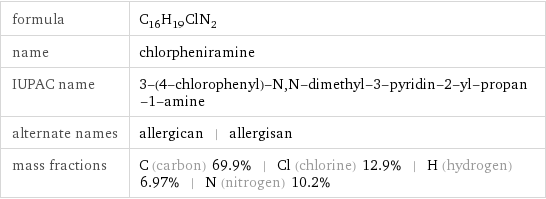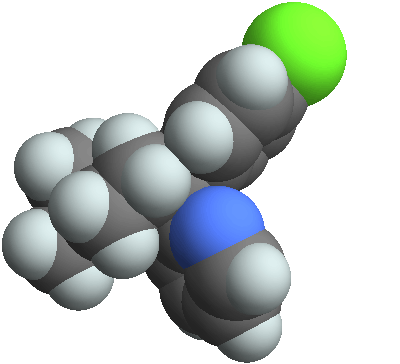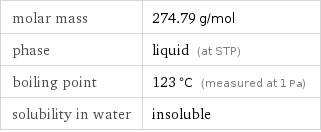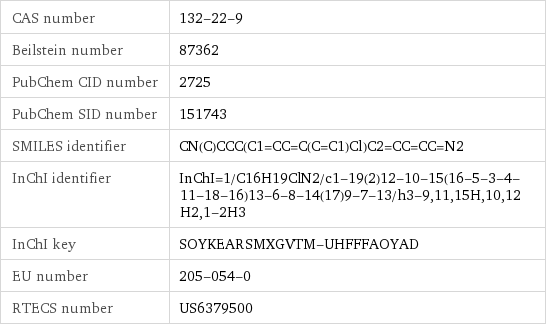Input interpretation

chlorpheniramine
Chemical names and formulas

formula | C_16H_19ClN_2 name | chlorpheniramine IUPAC name | 3-(4-chlorophenyl)-N, N-dimethyl-3-pyridin-2-yl-propan-1-amine alternate names | allergican | allergisan mass fractions | C (carbon) 69.9% | Cl (chlorine) 12.9% | H (hydrogen) 6.97% | N (nitrogen) 10.2%
Lewis structure

Draw the Lewis structure of chlorpheniramine. Start by drawing the overall structure of the molecule, ignoring potential double and triple bonds: Count the total valence electrons of the carbon (n_C, val = 4), chlorine (n_Cl, val = 7), hydrogen (n_H, val = 1), and nitrogen (n_N, val = 5) atoms: 16 n_C, val + n_Cl, val + 19 n_H, val + 2 n_N, val = 100 Calculate the number of electrons needed to completely fill the valence shells for carbon (n_C, full = 8), chlorine (n_Cl, full = 8), hydrogen (n_H, full = 2), and nitrogen (n_N, full = 8): 16 n_C, full + n_Cl, full + 19 n_H, full + 2 n_N, full = 190 Subtracting these two numbers shows that 190 - 100 = 90 bonding electrons are needed. Each bond has two electrons, so in addition to the 39 bonds already present in the diagram add 6 bonds. To minimize formal charge nitrogen wants 3 bonds and carbon wants 4 bonds. Identify the atoms that want additional bonds and the number of electrons remaining on each atom: Fill in the 6 bonds by pairing electrons between adjacent highlighted atoms. Note that the six atom rings are aromatic, so that the single and double bonds may be rearranged: Answer: | |
3D structure

3D structure
Basic properties

molar mass | 274.79 g/mol phase | liquid (at STP) boiling point | 123 °C (measured at 1 Pa) solubility in water | insoluble
Units

Hydrophobicity and permeability properties

experimental LogP hydrophobicity | 3.2 predicted LogP hydrophobicity | 3.74 predicted LogS | -3.72
Drug interactions

donepezil | ethotoin | fosphenytoin | galantamine | mephenytoin | phenytoin | rivastigmine (total: 7)
Basic drug properties

approval status | approved | small molecule drug categories | anti-allergic agent | antihistamine | antipruritic | histamine h1 antagonist dosage forms | oral: syrup | oral: tablet | oral: tablet, extended release

brand names | aller-chlor | allergican | allergisan | antagonate | chlo-amine | chlor-trimeton | chlor-trimeton allergy | chlor-trimeton repetabs | chlor-tripolon | chlorate | chloropiril | cloropiril | efidac 24 chlorpheniramine maleate | gen-allerate | haynon | histadur | kloromin | mylaramine | novo-pheniram | pediacare allergy formula | phenetron | piriton | polaramine | polaronil | pyridamal 100 | telachlor | teldrin
Chemical identifiers

CAS number | 132-22-9 Beilstein number | 87362 PubChem CID number | 2725 PubChem SID number | 151743 SMILES identifier | CN(C)CCC(C1=CC=C(C=C1)Cl)C2=CC=CC=N2 InChI identifier | InChI=1/C16H19ClN2/c1-19(2)12-10-15(16-5-3-4-11-18-16)13-6-8-14(17)9-7-13/h3-9, 11, 15H, 10, 12H2, 1-2H3 InChI key | SOYKEARSMXGVTM-UHFFFAOYAD EU number | 205-054-0 RTECS number | US6379500
Toxicity properties

RTECS classes | drug